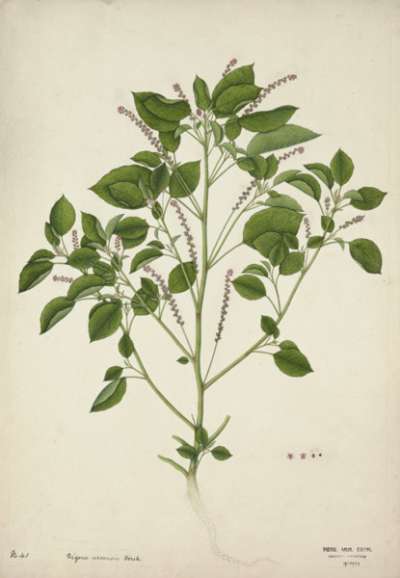Botanical drawing, kanjero
Kanjero (Digera muricata) has been used to treat digestive complaints, urinary disorders and leaf paste is applied to prevent pus formation.
This painting is part of local amateur botanist Richard Cresswell’s (1815-1882) collection. It is one of 86 Indian paintings (mostly botanical) and dates to the early 1800s. Many of the plants depicted in this collection were known for their use in Ayurvedic medicine. One of the world’s oldest medicinal systems, it has been practised in India for 3,000 years.
Between the late 18th and mid-19th centuries, the British East India Company extended its control over much of the Indian subcontinent. Keen to exploit and export valuable natural commodities, the Company set out to record the flora and fauna of India. It commissioned Indian artists to create detailed illustrations but officials rarely recorded their names. British scientists supervised the work and paper from England, made by companies such as Whatman, was imported for use.
The East India Company relied on Indian practitioners to help treat its officials as often the diseases they contracted had not been encountered before and western medicine proved ineffective. It also saw opportunity to export the plants used in medicine, and for food, dyes and timber, for huge profit exploiting India’s traditional knowledge systems and natural resources.
Responding to British patronage, Indian artists developed a new style of painting, mixing Indian and European traditions. This has come to be known as the ‘Company School’ art and these paintings belong to that broad tradition. It was common for officials (who were not employed as medics or botanists) to build their own personal collections of paintings. The flora and fauna depicted was sometimes from their own gardens and menageries.
We cannot be sure how Richard Cresswell came by this collection of Company School works. It is plausible they came to him via his wife’s family. Frances Creighton (1821-1904) was born in Bengal where her father, Robert (1797-1827), was a judge. Research suggests that his father was Henry Creighton (1764-1807). Charles Grant, a senior Company official, appointed Henry manager of an indigo factory at Guamalati. He is best known for his research and paintings on the ruins at Gaur. It is possible Henry commissioned the botanical drawings and they were passed down through the family. However, research has not yet uncovered any evidence for this connection.
17 of the 86 works have attributions on the reverse. These three artists, Sheikh Zain al-din, Ram Das and Bhawani Das, are known to have worked for Lady Mary Impey, wife of Sir Elijah Impey the Chief Justice of the Supreme Court of Calcutta. There is also evidence that they worked for Anna Maria Jones, the wife Sir William Jones, after the Impeys returned to Britain.
This painting is part of local amateur botanist Richard Cresswell’s (1815-1882) collection. It is one of 86 Indian paintings (mostly botanical) and dates to the early 1800s. Many of the plants depicted in this collection were known for their use in Ayurvedic medicine. One of the world’s oldest medicinal systems, it has been practised in India for 3,000 years.
Between the late 18th and mid-19th centuries, the British East India Company extended its control over much of the Indian subcontinent. Keen to exploit and export valuable natural commodities, the Company set out to record the flora and fauna of India. It commissioned Indian artists to create detailed illustrations but officials rarely recorded their names. British scientists supervised the work and paper from England, made by companies such as Whatman, was imported for use.
The East India Company relied on Indian practitioners to help treat its officials as often the diseases they contracted had not been encountered before and western medicine proved ineffective. It also saw opportunity to export the plants used in medicine, and for food, dyes and timber, for huge profit exploiting India’s traditional knowledge systems and natural resources.
Responding to British patronage, Indian artists developed a new style of painting, mixing Indian and European traditions. This has come to be known as the ‘Company School’ art and these paintings belong to that broad tradition. It was common for officials (who were not employed as medics or botanists) to build their own personal collections of paintings. The flora and fauna depicted was sometimes from their own gardens and menageries.
We cannot be sure how Richard Cresswell came by this collection of Company School works. It is plausible they came to him via his wife’s family. Frances Creighton (1821-1904) was born in Bengal where her father, Robert (1797-1827), was a judge. Research suggests that his father was Henry Creighton (1764-1807). Charles Grant, a senior Company official, appointed Henry manager of an indigo factory at Guamalati. He is best known for his research and paintings on the ruins at Gaur. It is possible Henry commissioned the botanical drawings and they were passed down through the family. However, research has not yet uncovered any evidence for this connection.
17 of the 86 works have attributions on the reverse. These three artists, Sheikh Zain al-din, Ram Das and Bhawani Das, are known to have worked for Lady Mary Impey, wife of Sir Elijah Impey the Chief Justice of the Supreme Court of Calcutta. There is also evidence that they worked for Anna Maria Jones, the wife Sir William Jones, after the Impeys returned to Britain.
Object Summary
- Accession Loan No.
- 19/1927/2/41
- Category
- Fine Art
- Collection Class
- Drawings
- Collector Excavator
- Cresswell, Reverend Richard (from the collection of)
- Medium
- watercolour on paper
- Common Name
- botanical drawing, kanjero
- Simple Name
- drawing
- Inscription Transcription
- HERB. MUS. EXON CRESSWELL COLLECTION 19/1927; Digera Arvensis Forsk; No 41
- Period Classification
- George III (1760-1811)
- Production Town
- Calcutta
- Production County
- Bengal
- Production Country
- India
- Production Person Initials
- Production Person Surname
- unknown Indian artist
- Production Year Low
- 1780
- Production Year High
- 1810


